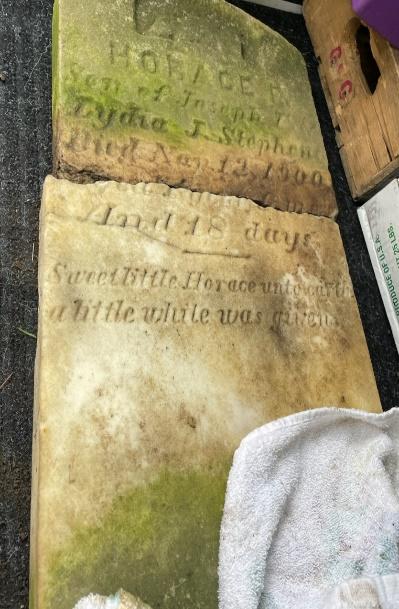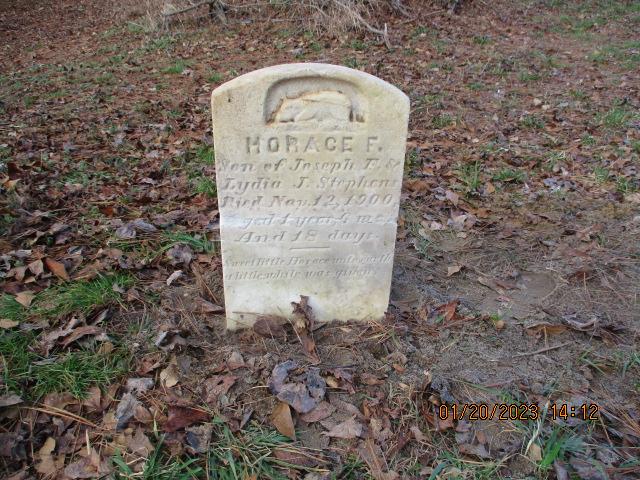Horace Stephen’s Odyssey
By Mark Watkins
There is a lovely brick colonial a few blocks north of the Square in Wadsworth known as the Shaffer House. It is surrounded by a black wrought-iron fence built in 1922 by Ross Trump, head of the Excel Rubber Company. The David Serbin family bought the house in 2006 and resided there until Fall of 2022 when they moved out of state. A moving sale was held soon afterward. Attending the sale were two Wadsworth citizens, Sue Fajt and Linda Beech. Perusing the merchandise, they spotted a headstone near a shed in the back of the property. It was in two pieces but had originally been 3 feet high and 18 inches wide. The inscription on the stone read: Horace Stephens Nov. 12, 1900 aged 4 yrs. 6m, 18d.
This piqued the interest of Sue and Linda. Linda, a member of the Friends of Woodlawn Cemetery, called Deb Holcomb, president of the organization. They also reached out to the selling agent, Barb Lesure of Howard Hannah Realty, who contacted the sellers and learned the following story:
The Serbin family had lived in Rehoboth Beach, DE before moving to Wadsworth, OH. At one point, while living in DE, the Serbin’s decided to replace the deck. Hidden under the old deck was the headstone of little Horace. They did not know when or why the headstone had been transported to Rehoboth Beach. Not knowing what to do, the Serbin’s placed the headstone out of the way near the deck. Years passed, and eventually they moved to Ohio settling in Wadsworth’s Shaffer House.
Residential movers, being efficient in their trade, packed up and moved everything not nailed down. Into a cardboard box and into the moving van went the headstone of poor Horace where it broke in two. Upon seeing the headstone had accidentally been brought to Ohio, the Serbin’s placed the pieces in an outbuilding at the back of the High St. property. On the day of the moving sale, the headstone was taken from the outbuilding with other items and placed on the ground. It was overlooked by those attending the sale and all leftover items would be disposed of at the end of the day. Sue and Linda took notice and contacted Deb Holcomb who, with the help of Barb Lesure, took possession of the headstone with permission of the Serbins.

Deb immediately put out a call to membership for help in finding any information concerning Horace’s headstone. It was obvious he was not a burial in Woodlawn Cemetery, Wadsworth, OH. FWC member, Mark Watkins, armed with a name, date of death, and a state, quickly found where Horace had been buried by using the free genealogy site, Find a Grave. Mark determined the burial site was the Stevens- Evans Family Cemetery in Selbyville, Sussex County, Delaware – about twenty-five miles south of Rehoboth Beach. The Find a Grave memorial stated that the stone was “recorded by the Hudson Survey but is now unreadable or not found”. The author of the memorial was a Find a Grave volunteer, Donald McClyment, of Queenstown, Maryland. Armed with his contact information, Deb Holcomb emailed him, and through a series of conversations, he agreed if FWC could get the headstone to his residence in Maryland, he would see that it would be properly restored at Horace’s grave in Selbyville.
Mr. McClyment then traveled to Selbyville to contact the property owners who were more than happy to have the headstone reset in the small cemetery on their property. In the meantime, it was decided to repair the headstone before being shipped from Ohio to Maryland. The headstone was turned over to Roger Havens, FWC member and president of the Wadsworth Area Historical Society. Using archivally approved products and methods, Roger cleaned, epoxied, and clamped the pieces back together. He then used a marble dust product to infill any cracks in the repaired headstone. Midwest Everlasting Memorials of Wadsworth were contacted concerning shipping and were instrumental in securing a freight company that would transport it to Maryland.
The repaired headstone was then taken to Midwest Memorials to be crated before shipping. A group consisting of Deb Holcomb, Linda Beech, Barb Lesure, Mark Watkins, and Roger Havens met to see the headstone off to Mr. McClyment who received the headstone on January 19, 2023 and reinstalled it the next day in the Stephens-Evans Family Cemetery in Selbyville, DE. Horace Stephens’ headstone was placed next to his father’s grave who, sadly, died a mere 10 months before Horace. This ends the odyssey of Horace Stephen’s headstone. His short life will have made a difference as long as we do not forget.

Friends Of Woodlawn Cemetery would like to thank everyone involved in this project, especially Donald McClyment for his diligence in posting information on Find a Grave and for his full cooperation in this project. Thank you, also, to Sue Fajt, Linda Beech, and Barb Lesure for caring enough to reach out to FWC for help and to Midwest Memorials for working with us to ship the headstone to Maryland/Delaware. It was a pleasure for the FWC volunteers to help bring the headstone of Horace Stephens full circle to his rightful resting place alongside his family members.

(Headstone Inscription)
Horace F.
Son of Joseph F. &
Lydia J. StephensDied Nov. 12, 1900
Aged 4 yrs. 6 mo.
and 18 days
Sweet little Horace unto earth
A little while was given
Hidden Heroes of Wadsworth: Julia Williams
By Michelle Waugh
Most people interested in Wadsworth history are familiar with family names such as Pardee, Lyman, Curtis, Hinsdale and others. These pioneer families, who settled in the area during the early 1800’s, also built the foundations of the city of Wadsworth that we know and love today. Many of these brave souls lie resting beneath the grassy, gentle green slopes of Woodlawn Cemetery. Their beautiful, time- worn monuments stand as a testament to the lives they lived in Wadsworth, long before we were born.
Despite the wealth of knowledge about our town’s early settlers, there are still many stories in danger of being forgotten. There are early residents of Wadsworth buried, without headstones, in unmarked sections of Woodlawn. Any markers or memorials their loved ones placed at their graves, are long gone. What is worse, the records that identify the people buried in these areas are sketchy, at best, and difficult to transcribe. Some of them were firsthand witnesses to the horrors of slavery in the saddest chapter of our nation’s great history. These African Americans came to the North after the Civil War in search of a better life. They settled in Wadsworth, bought homes, raised families, and became a vital part of the community. They, like other early citizens, deserve to not be forgotten.
One of those early settlers was an African American woman named Julia Williams. Although her actual grave site has not been identified at this time, it is fortunate that her story has been preserved. In 1936, President Franklin D. Roosevelt enacted the Federal Writers’ Slave Narrative Project. This was an effort to collect and record stories of former slaves throughout the entire country. Julia participated in this project. She was the only person from Medina County that participated.

Julia Williams was born a slave in Chesterfield County, Virginia. Like many former slaves, she did not know her exact date of birth. Her mother and father were both field laborers. She was so young when her father died that she did not even remember his name. Julia herself worked from a young age as a house maid. She stated that she had been fortunate her masters had been a little better than most. However, she remembered that runaway slaves were severely whipped when caught. She recalled that it was forbidden to hold or even look at a book, let alone learn to read or write. She was also able to describe what it was like when her people heard the glorious news that they were free men and women. She continued to work as a house maid after the Civil War, only this time as a paid worker. She married her husband Richard Williams, a general laborer, in 1867.
Julia and Richard Williams became part of Wadsworth’s history around 1877, during the great Loomis Coal Mine strike. These mines were located just south of town. The workers went on strike, demanding better wages and conditions. Desperate, the managers recruited many former slaves from Virginia and other southern states. They even transported them by train to Doylestown. Most of these former slaves were unaware they were breaking a strike. Some returned to their homes in the South when they found out. Others, like Julia’s husband Richard, chose to stay in Wadsworth. They first built small shacks to live in. Later, when times were better financially, they purchased their own homes. Julia and Richard bought a small house on Kyle Street. It is still there today.
In spite of not being able to read or write, Julia was a charter member of the First Baptist Church on Mills Street. She confessed that she had never been baptized, but her faith was deep. She declared, “I think the Lord he does everything right. The Lord opened my way”.
Julia Williams died on November 27, 1937, just one year after her story was recorded. She is buried somewhere in an unmarked section of Woodlawn Cemetery in Wadsworth. Julia and Richard had eight children, four of which survived. According to available records, their names were Lemuel, Elick (Alex, Alexander), Lula, and Thomas. As of the 1940’s, she still had descendants living in Wadsworth.
Friends of Woodlawn Cemetery, Wadsworth OH is currently in the process of identifying and listing as many people as possible who, like Julia, are buried in unmarked sections of the cemetery. We aim to compile a list of names that is as complete as possible. The intent is to memorialize them in some manner. Friends of Woodlawn Cemetery is attempting to reach out to the African American community and others who may have memories of such burials at Woodlawn. This includes stories and recollections of early African American families in Wadsworth. We are especially interested in the Julia and Richard Williams family and the Luther and Lucy “Annie” (or “Auntie”) Lee family.
Anyone interested in sharing information can contact Friends of Woodlawn Cemetery through Facebook or email Michelle Waugh at mwaugh0903@gmail.com. For the Julia Williams’ story, as well as other former slave stories included in the Federal Writers’ Slave Narrative Project, please visit this link.